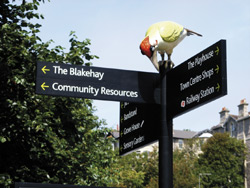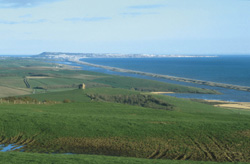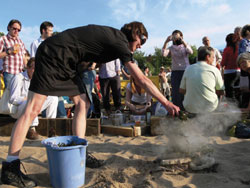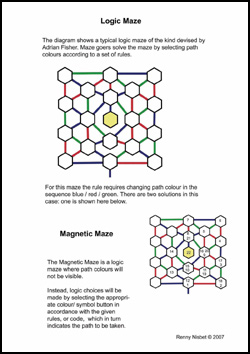PASW Regional Newsletter: Autumn 2007
Focus On Current Projects & Issues
PASW Planning Associate
I have been in post now for three months, the period I described as my slow start given my current projects in Weston super Mare. All of these will add to the now growing range of artist work that is helping to regenerate the seaside town. Last month the pedestrian signage system was installed which incorporates the bird finials designed by Cod Steaks.

Bird finials for pedestrian signage system,
designed by Cod Steaks, Weston super Mare.
My detailed knowledge of the region has increased considerably as a result of spending my first month researching each of the authorities via their web sites. In reviewing the current planning documents there already appears to be a recurring theme of design quality, something often requested but rarely defined. A significant part of my role will be to review planning policies and strategies around the region in order to ensure that the benefits of creative design practice and the integration of public art are represented and encouraged particularly as part of regeneration proposals and public realm enhancements.
A small number of specific projects have been identified where I will be looking to encourage creative design practices, and help facilitate how this can be achieved in practice. One such project is the development of a new community at Sherford in South Hams. Promoted by the Prince’s Trust this project looks to establish a new urban area of up to 4,000 dwellings and associated facilities by 2016 on the eastern edge of Plymouth.
Sherford raises the challenge of creating places in relatively short timescales. There is an active debate about how to incorporate more contemporary approaches to creative and quality design solutions. Given the scope for future urban expansions set out in the current Regional Spatial Strategy it is important that developments such as Sherford are implemented in ways that reflect the distinctive characteristics of the South West region, but also meet the environmental and aesthetic aspirations of the 21st Century. The role of artists as creative thinkers and designers can add considerably to the success of this.
Mark Luck, [email protected]
Groundwork South West
By the time you read this, Groundwork will have found its first artist-in-residence. In fact, he or she may already have started to work alongside our local trust, Groundwork Devon and Cornwall. Our intention from this point on is to have a regular programme of artists-in-residence, cross-fertilising our work and theirs and engaging in critical debates around contemporary art, regeneration and community. This will be a new experience for both parties, and the hope is that we both gain in knowledge and expertise - and that this will have a positive impact on the way that we work within and for communities. We now have a section on our website (www.groundwork-sw.org.uk) dedicated to our art programme. We will be adding updates on the residencies, collaborations, student mentoring etc. as things develop. This is most definitely a work-in-progress, so watch this space.
Ray White, [email protected]
Gloucester to Transform, Public Art has a vital role
Gloucester is set for transformation with GHURC attracting a £1billion private sector investment into the city over the next 10 years. This massive regeneration programme is about to create a new chapter in the history of Gloucester, building upon its world-class heritage and realising its potential as a city for the 21st century. Public Art will play a vital role in the City’s distinctiveness and vibrancy.
The Gloucester Heritage Urban Regeneration Company Ltd (GHURC) is responsible for Gloucester’s renaissance which will lead to 3,000 new homes, 2,000 new jobs, the restoration of over 90 heritage buildings and the redevelopment of nearly 100 hectares of largely derelict land that will transform Gloucester's historic city centre and waterfront areas. Collectively these areas of regeneration are referred to as ‘The Magnificent Seven’. GHURC have taken bold steps to ensure that public art is seated firmly in the strategic vision for a new Gloucester. Public Art consultants Gingko Projects Ltd have created a public art strategy, ‘A Place for Art’, which has been adopted by the GHURC board. Further details about the Magnificent 7 and the strategy can be found at www.gloucesterurc.co.uk. Public Art consultant, Gerry Wall, has been contracted by GHURC to create a high quality public art programme based on ‘A Place for Art’ which will be integrated within the Magnificent 7.
Gerry Wall, [email protected]
The Jurassic Coast Arts Programme
The Jurassic Coast World Heritage Site Team has recently issued a contract ready to commence the implementation of the Jurassic Coast Arts Programme. The 12 month brief involves a range of tasks, such as introducing an arts project protocol, developing event themes, working up ideas for the Cultural Olympiad (2008 – 12) and preparing a comprehensive funding plan to take the initiative forward.

Chesil from Abbotsbury
Photo: Richard Edmonds
A partnership, Chris Huxley and Crystal Johnson, have been appointed to carry out this work. Chris was recently in charge at Bridport Arts Centre in West Dorset and Crystal is well known throughout the region from her work with Arts & Business. Both Chris and Crystal bring a wealth of arts management experience to the project.
Their work follows on from the publication of the Jurassic Coast Arts Strategy in 2005 (the Jurassic Coast is believed to be the only WHS to have such a strategy) which will form the bedrock of the unfolding Arts Programme.
This autumn, the pair will be hosting a series of “Dialogue” sessions along the coast to help keep everyone up to date with developments.
For further details, or to join the Jurassic Coast Arts mailing list please contact [email protected] or telephone 01308 426562.
Bristol Focus 2007
2007 continues to be an exciting year for public art in Bristol with a wide range of projects and Artists coming to work in the City. This breadth of public art commissioning reflects the City’s current ambitious and buoyant development activities.
Bristol City Council has just commissioned muf to develop a temporary public art project at the site of Bristol Urban Beach on Redcliffe Wharf this summer, which will continue until October 2007.
Katherine Clarke [muf] is leading on the project and working with the Chatterton Society in Bristol. Bristol Urban Beach has been developed by Demos in partnership with Bristol City Council.

muf on Bristol Urban Beach, as part of their
talk on public art & presentation, July 07
Elsewhere, Ginkgo projects are leading on a wide range of public and commercial developments across Bristol City. These include Merchants Academy and the Former GPO Sorting Office. Merchants Academy is an innovative model working with pupils to embed creativity into the built fabric of the building through working with Young Enterprise to set up a pupil centred research student company working in collaboration with associated selected artists.
Bristol Focus 2007 cont.
Bristol’s Former GPO Sorting Office is being redeveloped into a new creative hub for Bristol. London Fieldworks are working as lead artist to develop physical interventions within the development. The first project that is being developed includes the Colour project, which addresses the facade treatment of this landmark building. Ginkgo are also working collaboratively with the UWE based group Situations on further offsite projects to build links between the site and Bristol’s creative communities through animation, debate and projects that promote the evolving nature of the site.
Bristol Harbourside development continues its progressive programme of public art being lead by Lead Artist Tim Knowles. Forthcoming commissions include works by Daphne Wright, Sans Façon, Julie Verhoeven and Simon Faithful.
Insite Arts continue their development of Broadmead’s Public Art Programme. Broadmead is Bristol’s primary retail focused city centre development covering over 11 hectares of city space. Artists developing commissions include Nayan Kulkarni, Susanna Heron, Timorous Beasties, Esther Rolinson and Artist in residence Neville Gabie. Broadmead is due to open to the public Autumn 2008.
Further information & links:
Emma Johnston: Senior Public Art Officer, Bristol City Council
Emma has now left Bristol and the post is currently undergoing recruitment.
Sculpture Gardens at Porthcurno
Telegraph Museum
A new series of sculptures that represent the scientific concepts underlying the Porthcurno Telegraph Museum are being developed to make the subject more accessible to a wider audience.
Porthcurno Telegraph Museum has arguably the most comprehensive collection of early communication technology in Britain covering early telegraphic equipment through to fibre optics and radio. The museum is working with artists to explore ideas of visualising forces and fields to help the non-scientist to build a visual image of what is there. The museum is bringing artists together with GCSE science students to explore ideas which will lead to the development of the sculptures. The result will be a range of different interpretations using a variety of styles and materials that will inspire the audience and stimulate their imagination while encouraging them to develop their own mental model of how these forces work.

‘Logic Maze’, design ideas for artwork for the
Sculpture Gardens at Porthcurno Telegraph Museum.
The sculptures will take into account different learning styles (visual, aural, kinetic) and the artists’ brief will specify that the objects will have to be ‘touchable’ to allow full access by those with visual or learning difficulties as well as giving a tactile experience to those who respond to such stimulus.
The Sculpture Garden will be sited in the grounds of the museum. The sculptures will be supported by information panels explaining the underlying scientific principles in words, diagrams and pictures and relating the whole visual experience to the items in the museum by the use of photographs and other images, for example, Victorian etchings.
The sculpture garden will be launched in Science Week 2008.
Devon Quality Design Initiative
Devon Quality Design Initiative has grown over the past few years from its beginnings as the Devon Public Art Consortium. Following a review, instigated and supported by PASW, of the work of the Public Art Consortium, all Devon authorities were approached with a view to exploring common and key issues of public art development. Subsequently a loose working group of representative planning and arts officers and PASW agreed to establish Devon Quality Design Initiative.
Earlier this year, consultants Gerry Wall and Lisa Harty were appointed to develop and deliver the Initiative. Alongside aspirations to develop strategic, shared resources, act as a forum for debate and training, the DQDI will concentrate on delivery of an action plan that focuses on a programme of activities and the creation of a sustainable and supported future.
Work is currently underway on creating a website and identity for DQDI and mapping out the initial programme of activities. Further details will follow in due course. Financial and resource support continues to be offered by PASW, Teignbridge District Council, Devon County Council, South Hams District Council and West Devon Borough Council.
Lisa Harty, [email protected]
